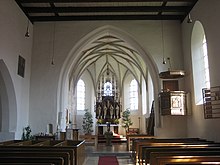Our women (Woringen)
Our women is the Evangelical Lutheran parish church in the Swabian Woringen in the Unterallgäu district , Bavaria .
history
The existence of churches in Woringen was first recorded in 1350. At that time there were two churches, the Martinskirche, demolished in 1806 on today's cemetery grounds and a church in the south of the village, towards Zell . The parish church was commonly referred to as Marienkirche .
Allegedly with the Reformation in Woringen in 1532, the name Marienkirche changed to Frauenkirche or Our Women . The All Saints Chapel, built in 1477, was connected in 1857 by pointed arches to the main nave as the left aisle.
In 1959 excavations were carried out in the northern garden of the church, among other things, where the remains of two Romanesque apses and the foundations of an early Gothic nave with choir were found.
Building description
The church is a largely unplastered Nagelfluhbau . The All Saints Chapel and the upper floor of the tower are plastered. The choir consists of two bays with a 5/8 end and ribbed vault. The nave is flat-roofed and contains four window axes. The wooden gallery to the west dates from the 17th century.
Furnishing
The pulpit , built in 1658 in the Renaissance style, was painted in 1661 by Johann Sichelbein . Christ and the four evangelists are depicted with their attributes. During the renovation in 1972, the neo-Gothic ornaments were removed and the pulpit was restored to its original appearance.
The altar was carved by the Memminger Vogt and Schmitz in 1892 . In the middle the crucifixion scene of Jesus is shown, which is framed on the right and left by Mary and the disciple John. In the altar fields, Peter is depicted with a key on the left and Paul with a sword and Bible on the right.
In 1962 and 1969, the frescoes on the north wall of the apse, which had been painted over during the Reformation, were uncovered. This fresco cycle comes from the Memmingen Strigel family and is dated to around 1490. The frescoes are laid out as Bible for the poor in order to convey the Christian faith to the congregation who is not able to read.
The baroque gallery was built in 1684. The painting by Johann Friedrich Sichelbein depicts the apostles.
Epitaphs
There are four funerary monuments in the church. The oldest epitaph dates from 1477 and is attached to Anshalm von Eyb . In 1668 another epitaph was erected for Johann Lang and Paulus Brommer. For Juliana Stebenhaber († 1716) a tomb was made from red sandstone. An epitaph inscription for Johann Caspar von Wachter († 1787) is made from Solnhofen plaque.
Bells
There are four bells in the tower of the parish church.
Bell i
This bell, cast in Biberach by Hans Follmer II in 1502 , has been hanging in Woringen since 1806. The inscription reads: HOC NOCVA CEDANT HOSTIS ET A VRA SONO ANNO DOMINI MCCCCCII - (The mild tone drive away the harmful forces in the year of the Lord 1502). The symbols used are Peter with a key and the coronation of Mary. It is the strike note. It is a chime bell, which is rung on Saturday at 2 p.m. and on Sunday at 8 a.m. Root note in the full four-note sound of the peal.
Bell II
The bell of love was cast on March 18, 1988 in Karlsruhe . The inscription reads: LOVE IS LONG-MOODED AND FRIENDLY. LOVE DOESN'T EXCIT. LOVE DOES NOT DRIVE COURAGE. IT DOES NOT FLELL. SHE DOESN'T PLAY UNBELD. SHE'S LOOKING FOR HER. SHE WILL NOT BE BITTER. SHE DOES NOT ASSUME THE EVIL. SHE DOESN'T ENJOY INJUSTICE. BUT SHE'S LOVING THE TRUTH. SHE WEARS EVERYTHING. SHE TOLES EVERYTHING. STRIVE FOR LOVE. A monogram of Christ is attached as a symbol. The strike tone is sat. It is the morning bell, which is struck at 11:00 a.m. It is the our father's bell and the wedding bell.
Bell III
This bell, which was also cast in Karlsruhe on March 18, 1988, is a re-casting and replacement for the bell from 1921 that was melted down during the war. The inscription reads: IN SERIOUS TIMES I WAS CREATED, LORD GOD BE MERCY TO GERMAN LANDS. TO REMEMBER THE 1000 YEAR EXISTENCE OF THE CHURCH OF WORINGEN 948 - 1948 . The crucifixion of Jesus is appropriate as a symbol. The chime is as. It is struck at 12:00 noon and as an evening bell.
Bell IV
Like the first bell, that of Hans Follmer II was cast in Biberach in 1523. The inscription reads: HELF VNS GOT ANNO DOMINI MCCCCCXXIII . The strike note is ces (h). It is the baptismal bell and the children's church service bell. Together with bell III, it also rings the transfer bell. Stable bell in the summer months, former civil service bell.
See also
literature
- Tilmann Breuer : City and District of Memmingen . Ed .: Heinrich Kreisel and Adam Horn. Deutscher Kunstverlag, Munich 1959, p. 236-237 .
Web links
Individual evidence
- ^ Tilmann Breuer; Heinrich Kreisel and Adam Horn (eds.): City and district of Memmingen . Deutscher Kunstverlag, Munich 1959, p. 236
- ^ Tilmann Breuer; Heinrich Kreisel and Adam Horn (eds.): City and district of Memmingen . Deutscher Kunstverlag, Munich 1959, pp. 236, 237.
Coordinates: 47 ° 55 ′ 19.8 ″ N , 10 ° 12 ′ 8.1 ″ E









